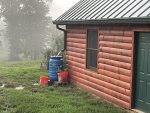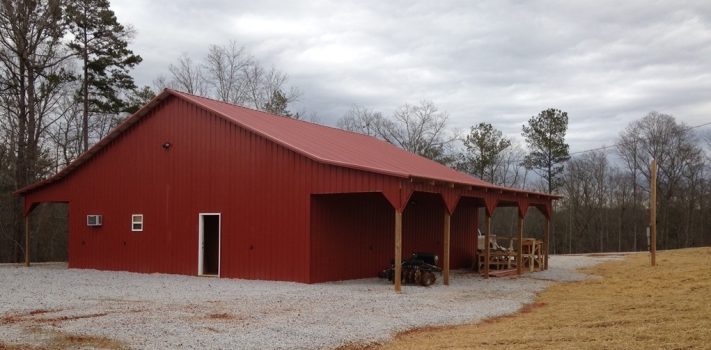Addressing the problems facing aging preppers.
Start early!
Our initial problem was two-fold: Finding sustainable land while still trapped until I was retirement-eligible. Two years before retirement, we began our search for viable land approximately 100 miles from any major city. Our initial search was for about 20 acres, a nearby small town, and off of well-traveled roads. The land had to have a water source with a full-year-running creek.
Remember moving to an unknown rural community places you at a disadvantage of finding appropriate skilled help and unscrupulous persons who will overcharge you based on your lack of knowledge.
After locating a property, we purchased the acreage. About two-thirds of the property was clear-cut for pine lumber some 4 to 5 years earlier, which left an overgrown mess of brambles, briars, and debris The costs of clearing the land was substantial and we had not really budgeted for the costs. Not having any farming background was a disadvantage.
If you are in the market for land, do not assume that the low cost of the acreage is better than a more expensive acreage that is already cleared and usable.
About one year from my retirement, we began initial improvements. We paid to bulldoze a path/driveway towards the rear of the property and clear a place for a 40×40 metal barn with 10 ft overhangs on both sides. Due to the distance between our current home to the property being about 100 miles, my husband was ingenious in designing the barn. Inside the barn, 1/4 of the space was used to build a fully functional apartment. We created our own little residence inn that included bathroom with sink, toilet, and shower. One wall contained a kitchen sink, microwave, stove, refrigerator and cabinets. It contained a small closet and the room for a bed and small table for eating. It was completed with a dual ac/ heating window unit.
Additionally, a septic system, well, and electricity was included in the build. This allowed us to come to the property on long weekends and vacation time to oversee the building of our home and begin moving woodworking equipment/storage etc. to the barn.
We were able to monitor any movement via a camera connected to our phones. If you are in a similar situation of trying to get away from the city, but are prevented by your current work situation, this is a good idea, that enables you to begin the process of relocating. Also, during the building of the barn, it seemed like all of the locals showed up one day to examine the strange barn concept.
I believe it was imperative to demonstrate the security system we installed to show local inhabitants the immediate notifications on our phones. I believe this may have prevented loss of property.
The building of the main home became a nightmare of costs, problems, and delays. As with any construction, you can’t move forward on other items until the first is completed. In a rural setting, you are dependent upon the availability of local sub-contractors which can delays of weeks to months.
The basement of the home was constructed of 10” poured reinforced concrete. We determined that the additional costs of a secure foundation plus especially strengthened roofing would be our major concerns. The basement would provide significant storage/ reloading area but also provide substantial support for the home.
The building of the home turned into “the good, the bad, and the very ugly”!
Considerations as to primary outside construction were made. We debated over the types of materials. Siding vs brick facade vs stucco vs log home. From our protection standpoint, we decided on a log home for the following reasons: bullets don’t penetrate 6” logs as easily as stucco, vinyl etc. Log homes have a very good insulation factor vs other materials. It costs less to heat or cool.
The ugly….do not build two stories on top of basement as it is too costly to maintain. It will be more efficient to build lengthwise. Log homes require extensive maintenance. Most importantly, find a legitimate knowledgeable contractor. Do not rely on the website testimonial recommendations from the company selling you the log home “kit”. Our former contractor now has an “F” rating with the BBB. Beware: They just change names and perform the same methods of poor construction and rip offs of money.
The years pass fast! Though we started early in determining our desire to vacate the city, it ended up taking approximately three years to finally finish moving into the house with a barn and basement full of boxes. As the years pass, so does your health and ability to accomplish the chores of rural living. I believe if we had started this process in our forties we would be much more able to sustain rural lifestyles. Waiting until your sixties, is not recommended.
So the homestead was built, but that is just the beginning. Now comes clearing land, plowing, sowing, et cetera. The planning of orchards, gardens, sheds, additional water sources and it seems like a million more things to be done. The seasons seem to speed by. My husband is pretty much confined to the home, which leaves the majority of the outside chores to me. Now five years later, I cannot work for 8 hours outside.
I am relying on having to pay for significant improvements to the property which at one time we thought we could do ourselves. Therefore, now on retirement income, we choose a major project each year for improvement.
I would not trade the mistakes, lack of financial resources or anything else for the home we currently have.
Projects for aging
However, regardless of your small stature or age, there are still important projects you can do to improve your homestead.
I determined the need for a woodshed to hold 2-3 cords of wood. After looking at numerous free tutorials I decided to give it a try. A lot of the builds, I considered to be premium and costly. Solutions, use your imagination and available resources.
I proceeded to determine the size recommended and purchased enough concrete blocks for support of the shed. Next, instead of newly purchased lumber, I decided to use pallets for the sides of the shed. Look around, find a store closing or other location that contains a lot of pallets. I found a store closing and tons of pallets out back. A quick inquiry, resulted in four trips in the pickup truck to pick up free pallets for the build. I had several sheets of plywood in the barn for flooring. I put down the plywood flooring on top of the blocks and then secured the pallets to 3 sides of the shed. I placed leftover 2×6” studs to the corners and in the center to support a roof. I intentionally ensured there was a decline in the height of the roof supports to allow for drainage.
The most difficult part for me, was constructing a roof. I could not easily manage the weight of the heavy plywood. I managed to correctly use 8 sheets of 3/4” plywood for beginning the roof. I had leftover tar paper to cover the plywood but found the weight of shingles to be overwhelming for me. I found the cost to be high, as well. Instead, I purchased prefab composite siding which could be linked or joined together for the top of the roof. Finally, I went to the big box store and went to their paint departments and found their mismatched leftovers an claimed an outdoor 5 gallon bucket of paint for $10. Thus completed my ugly but sturdy wood shed.
 The next project was to assemble and install water barrel recovery system to provide additional water for my orchard, garden and berry bushes. Locating used 55 gallon plastic drums is generally easy and cheap. Purchasing was restricted to the necessary faucets, overflow valves. I had an eight foot long 2” plastic pipe leftover from construction and used this in small sections to connect one barrel to another for rain collection. I needed to alter the downspouts off of the garage and the rear of the house to flow the water directly into the water barrels.
The next project was to assemble and install water barrel recovery system to provide additional water for my orchard, garden and berry bushes. Locating used 55 gallon plastic drums is generally easy and cheap. Purchasing was restricted to the necessary faucets, overflow valves. I had an eight foot long 2” plastic pipe leftover from construction and used this in small sections to connect one barrel to another for rain collection. I needed to alter the downspouts off of the garage and the rear of the house to flow the water directly into the water barrels.
The building of raised beds for berry bushes and a garden, was fairly easy using again left over pretreated lumber from our home construction. This is fairly easy to construct using 2×4 pieces for the supports and 1×6” or 1×8” pieces for the sides. Using the tractor, I filled the beds with topsoil. I spent time sifting through the top soil to remove unwanted rocks, weeds, etc. I added garden soil to prevent the beds from becoming too dense for growing. I use an electric garden pump to connect hoses from the barrels to the beds for watering during a drought. I need to move one of the raised beds closer to the irrigation system. I locally purchased numerous fruiting trees and planted them at various intervals.
I have had success with the apple trees and peach trees. Nothing yet from apricot, plumclot, persimmon, pears, or fig trees yet. I need to learn more to increase their growth and production.
The next issue was installing duplicate types of alarm systems. I purchased solar alarms and a base station that I have mounted from the front entrance at our gate and at intervals along the driveway. Each has a distinctive sound and allows me to determine where along the driveway a vehicle is approaching. These a good and require no maintenance. A second camera/alarm system was installed to provide real-time motion sensor alerts. Since this is a battery system, the batteries must be recharged. The sensors were placed above average height to prevent the ease of removal. I purchased solar panels to recharge the batteries to prevent me from using a ladder to recharge the batteries. They provide me comfort and send alerts to the phones.. Additional alarms were installed on doors, glass break sensors on windows, and motion detectors while away.
We have the beans, bullets and bandaids, as well as the “list of lists” promoted to become self-sufficient. I have not developed a lot of skills still needed but I am still working on them.
As I look back, I feel like there are some recommendations needed to be made:
Start young!
Determine the likelihood of family support. Be realistic. Will your children really return? Will many of your family pass? Will the homestead just be used for you as couple? Do you really need all that bug-out bag equipment in your late 60s? I am not running anywhere, now.
The takeaway is to make sure you take a realistic look at your age, income, and health. All of those can change in a minute causing you to constantly adjust your desire to become self-sufficient.
Continue Learning!
I still read SurvivalBlog every day and really enjoy TunnelRabbit and St. Funogas as they are very instructive but many times what they describe is over my head.
I visit a local farm for my purchases of trees and bushes and return often to ask for guidance on improving their growth. May God bless all of the readers of SurvivalBlog.










